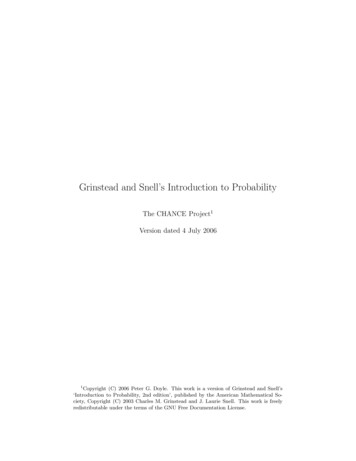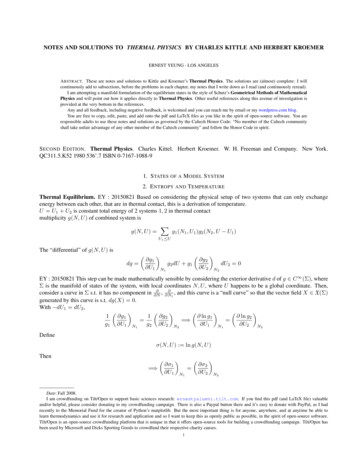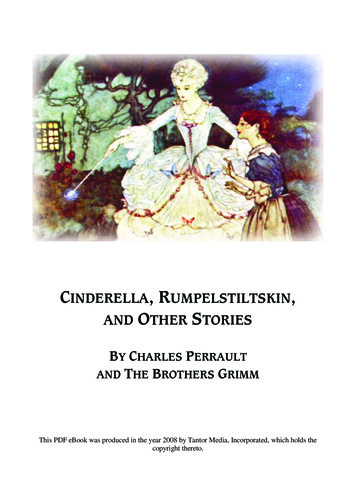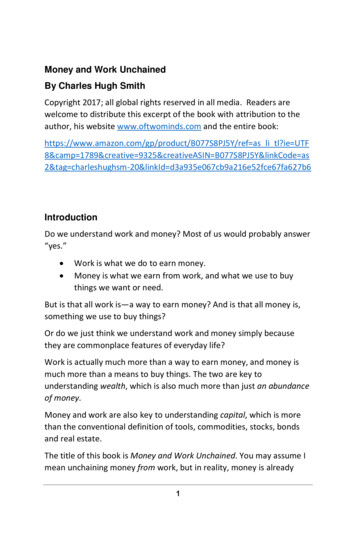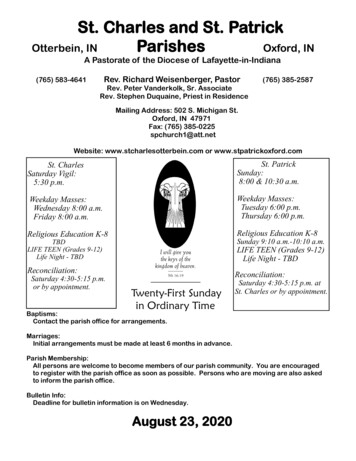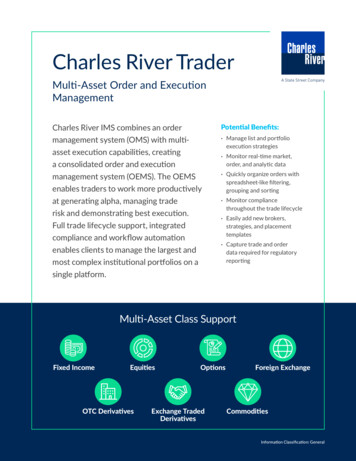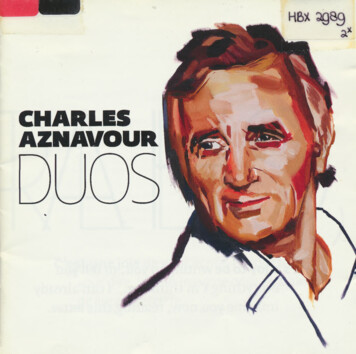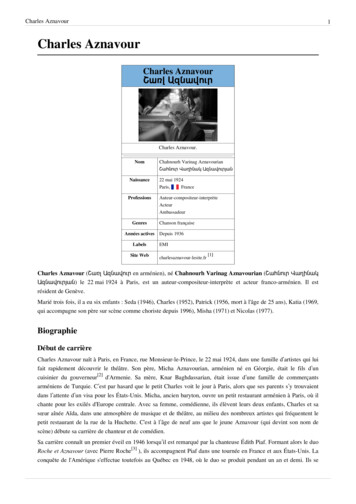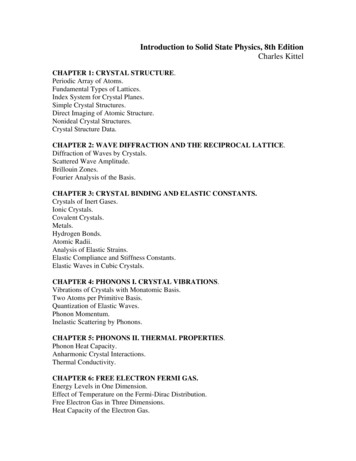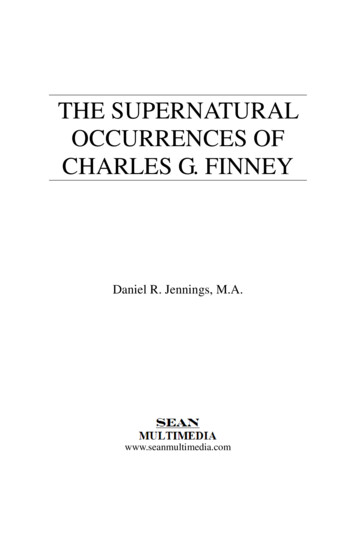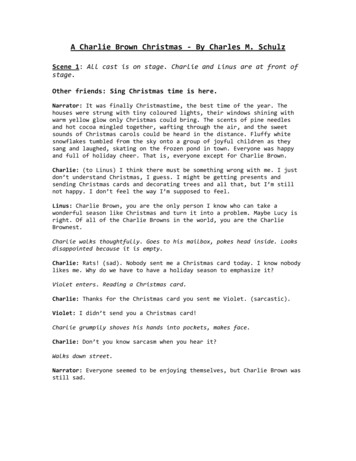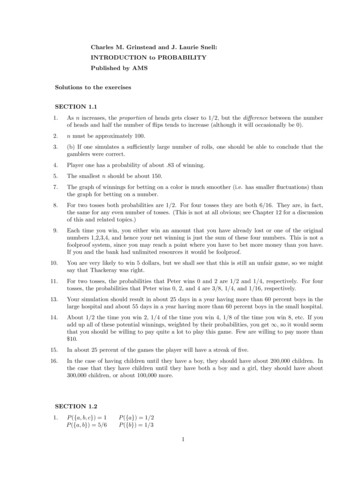
Transcription
Charles M. Grinstead and J. Laurie Snell:INTRODUCTION to PROBABILITYPublished by AMSSolutions to the exercisesSECTION 1.11.As n increases, the proportion of heads gets closer to 1/2, but the difference between the numberof heads and half the number of flips tends to increase (although it will occasionally be 0).2.n must be approximately 100.3.(b) If one simulates a sufficiently large number of rolls, one should be able to conclude that thegamblers were correct.4.Player one has a probability of about .83 of winning.5.The smallest n should be about 150.7.The graph of winnings for betting on a color is much smoother (i.e. has smaller fluctuations) thanthe graph for betting on a number.8.For two tosses both probabilities are 1/2. For four tosses they are both 6/16. They are, in fact,the same for any even number of tosses. (This is not at all obvious; see Chapter 12 for a discussionof this and related topics.)9.Each time you win, you either win an amount that you have already lost or one of the originalnumbers 1,2,3,4, and hence your net winning is just the sum of these four numbers. This is not afoolproof system, since you may reach a point where you have to bet more money than you have.If you and the bank had unlimited resources it would be foolproof.10.You are very likely to win 5 dollars, but we shall see that this is still an unfair game, so we mightsay that Thackeray was right.11.For two tosses, the probabilities that Peter wins 0 and 2 are 1/2 and 1/4, respectively. For fourtosses, the probabilities that Peter wins 0, 2, and 4 are 3/8, 1/4, and 1/16, respectively.13.Your simulation should result in about 25 days in a year having more than 60 percent boys in thelarge hospital and about 55 days in a year having more than 60 percent boys in the small hospital.14.About 1/2 the time you win 2, 1/4 of the time you win 4, 1/8 of the time you win 8, etc. If youadd up all of these potential winnings, weighted by their probabilities, you get , so it would seemthat you should be willing to pay quite a lot to play this game. Few are willing to pay more than 10.15.In about 25 percent of the games the player will have a streak of five.16.In the case of having children until they have a boy, they should have about 200,000 children. Inthe case that they have children until they have both a boy and a girl, they should have about300,000 children, or about 100,000 more.SECTION 1.21.P ({a, b, c}) 1P ({a, b}) 5/6P ({a}) 1/2P ({b}) 1/31
P ({b, c}) 1/2P ({a, c}) 2/3Ω Ω Ω Ω Ω P ({c}) 1/6P (φ) 02.(a)(b)(c)(d)(e){A elected, B elected}.{Head,Tail}.{(Jan., Mon.), (Jan., Tue.),. . . ,(Jan., Sun.),. . . ,(Dec., Sun.)}.{Student 1,. . . ,Student 10}.{A, B, C, D, F }.3.(b), (d)4.(a) In three tosses of a coin the first outcome is a head.(b) In three tosses of a coin the same side turns up on each toss.(c) In three tosses of a coin exactly one tail turns up.(d) In three tosses of a coin at least one tail turns up.5.(a) 1/2(b) 1/4(c) 3/8(d) 7/86.47.7.11/128.Art 14 , Psychology 21 , Geology 14 .9.3/4, 110.12.11.1 : 12, 1 : 3, 1 : 3512.34.13.11:414.(a) mY (2) 1/5, mY (3) 1/5, mY (4) 2/5, mY (5) 1/5(b) mZ (0) 1/5, mZ (1) 3/5, mZ (4) 1/515.Let the sample space be:ω1 {A, A}ω4 {B, A}ω7 {C, A}ω2 {A, B}ω5 {B, B}ω8 {C, B}ω3 {A, C}ω6 {B, C}ω9 {C, C}where the first grade is John’s and the second is Mary’s. You are given thatP (ω4 ) P (ω5 ) P (ω6 ) .3,P (ω2 ) P (ω5 ) P (ω8 ) .4,P (ω5 ) P (ω6 ) P (ω8 ) .1.Adding the first two equations and subtracting the third, we obtain the desired probability asP (ω2 ) P (ω4 ) P (ω5 ) .6.16.10 per cent. An example: 10 lost eye, ear, hand, and leg; 15 eye, ear, and hand; 20 eye, ear, andleg; 25 eye, hand, and leg; 30 ear, hand, and leg.2
17.The sample space for a sequence of m experiments is the set of m-tuples of S’s and F ’s, where Srepresents a success and F a failure. The probability assigned to a sample point with k successesand m k failures is 1 k n 1 m k.nn(a) Let k 0 in the above expression.(b) If m n log 2, then log 2 1 m1 nlim 1 lim1 n n nn log 2 1 n lim ( 1 n n log 2 e 1 1.2(c) Probably, since 6 log 2 4.159 and 36 log 2 24.953.18.(a) The right-hand side is the sum of the probabilities of all outcomes occurring in the left-handside plus some more because of duplication.(b)1 P (A B) P (A) P (B) P (A B).19.The left-side is the sum of the probabilities of all elements in one of the three sets. For the rightside, if an outcome is in all three sets its probability is added three times, then subtracted threetimes, then added once, so in the final sum it is counted just once. An element that is in exactlytwo sets is added twice, then subtracted once, and so it is counted correctly. Finally, an element inexactly one set is counted only once by the right side.20.We would have to have the same probability assigned to all outcomes. If this probability is 0, thesum of the probabilities would be 0 so that P (Ω) 0 instead of 1 as it should be. If this commonprobability is a 0, then the sum of all the probabilities of the first n outcomes would be na andfor large enough n this would be greater than 1, contradicting the requirement that the sum of theprobabilities for all possible outcomes should be 1.21.7/21222.Ω {1, 2, 3, . . .} and the distribution is m(n) (5/6)n 1 (1/6). Now if 0 x 1, then Xxj n 0Hence(1/6) X1.1 x(5/6)n 1 (1/6) ·n 123.We have Xn 024.m(ωn ) Xr(1 r)n n 01 1.1 5/6r 1.1 (1 r)He just meant that if you pick a month at random within a complete 400-year cycle of the calendarthe thirteenth of the month is more likely to fall on Friday than on any other day.3
25.They call it a fallacy because if the subjects are thinking about probabilities they should realizethatP (Linda is bank teller and in feminist movement) P (Linda is bank teller).One explanation is that the subjects are not thinking about probability as a measure of likelihood.For another explanation see Exercise 52 of Section 4.1.26.The probability that the two cards are of the same rank is8x 1727.Px P (male lives to age x) Qx P (female lives to age x) 28.(a)52·352·51 117 .Thus 2x 117 1 givingnumber of male survivors at age x.100, 000number of female survivors at age x.100, 00013(b) P3 (N ) [N3 ]N ,where [ N3 ] is the greatest integer inN3.Note that NNN 1 .333From this we see thatP3 lim P3 (N ) N 1.3(c) If A is a finite set with K elements thenA(N )K ,NNsolimN A(N ) 0.NOn the other hand, if A is the set of all positive integers, thenlimN A(N )N lim 1.N NN(d) Let Nk 10k 1. Then the integers between Nk 1 1 and Nk have exactly k digits. Thus, ifk is odd, thenA(Nk ) (Nk Nk 1 ) (Nk 2 Nk 3 ) . . . ,while if k is even, thenA(Nk ) (Nk 1 Nk 2 ) (Nk 3 Nk 4 ) . . . .Thus, if k is odd, thenA(Nk ) (Nk Nk 1 ) 9 · 10k 1 ,while if k is even, thenA(Nk ) Nk 1 10k 1 .So, if k is odd, thenA(Nk )9 · 10k 19 ,Nk10k 1104
while if k is even, thenA(Nk )10k 12 k .Nk10 110Therefore,limN A(N )Ndoes not exist.29.(Solution by Richard Beigel)(a) In order to emerge from the interchange going west, the car must go straight at the first pointof decision, then make 4n 1 right turns, and finally go straight a second time. The probabilityP (r) of this occurring isP (r) X(1 r)2 r4n 1 n 0r(1 r)211, 421 r1 r1 rif 0 r 1, but P (1) 0. So P (1/2) 2/15.(b) Using standard methods from calculus, one can show that P (r) attains a maximum at the values 1 51 5r .346 .22At this value of r, P (r) .15.30.In order to depart to the east, one must make 4n 3 right-hand turns in succession, and then gostraight. The probability isP (r) X(1 r)r4n 3 n 0r3,(1 r)(1 r2 )if 0 r 1. This function increases on the interval [0, 1), so the maximum value of P (r), ifa maximum exists, must occur at r 1. Unfortunately, if r 1, then the car never leaves theinterchange, so no maximum exists.31.(a) Assuming that each student gives any given tire as an answer with probability 1/4, then probability that they both give the same answer is 1/4.(b) In this case, they will both answer ‘right front’ with probability (.58)2 , etc. Thus, the probabilitythat they both give the same answer is 39.8%.SECTION 2.1The problems in this section are all computer programs.SECTION 2.21.(a)f (ω) 1/8 on [2, 10](b) P ([a, b]) b a8.5
2.(a)c 1/48.(b) P (E) 1296 (b(c) P (X 5) (d)3.(a) a2 ).7596 ,P (x 7) 4596.P (x2 12x 35 0) P (x 5 0, x 7 0) P (x 5 0, x 7 0)3 P (x 7) P (x 5) .4C 1log 5 .621(b) P ([a, b]) (.621) log(b/a)(c)log 2 .431log 5log(7/2)P (x 7) .778log 5log(25/7) .791 .P (x2 12x 35 0) log 5P (x 5) 4.5.(a) .04, (b) .36, (c) .25,(a)1 (b) 1 (c) 1 1e11e31e1(d) .09. .632 .950 .632(d) 16.(a) e .01T , (b) T 100log(2) 69.3.7.(a) 1/3, (b) 1/2, (c) 1/2, (d) 1/38.(a)1/8, (b) 21 (1 log(2)),(e) 3/4,(f) 1/4,(c) .75, (d) .25,(g) 1/8, (h) π/8, (i) π/4.12.1/4.13.2 log 2 1.14.(a) 13/24, (b) 1/48.15.Yes.16.Consider the circumference to be the interval [0, 1], as in the hint. Let A 0. There are twocases to consider; 0 B 1/2, and 1/2 B 1. In the first case, C must lie between 1/2and B 1/2, for otherwise there would be a gap of length greater than 1/2, corresponding to asemicircle containing none of the points. Similarly, if 1/2 B 1, it can be seen that C must liebetween B 1/2 and 1/2. The probability of one of these two cases occurring is 1/4.SECTION 3.11.242.1/123.2326
4.At this writing, 37 Presidents have died. The probability that no two people from a group of 37(all of whom are dead) died on the same day is about .15. Thus, the probability that at least twodied on the same day is .85. Yes; Jefferson, Adams, and Monroe (all signers of the Declaration ofIndependence) died on July 4.5.9, 6.6.Since we do not get a different situation if we rotate the table we can consider one person’s positionas fixed, and then there are (n 1)! possible arrangements for the other n 1 people.7.8.5!.55Each subset S corresponds to a unique r-tuple of 0’s and 1’s, where a 1 in the i’th location meansthat i is an element of S. Since each location has two possibilities, there are 2r r-tuples, and hencethere are 2r subsets.10.1/1311.3n 2 728,,.n327 100012.(a) 30 · 15 · 9 4050(b) 4050 · (3 · 2 · 1) 24300(c) 148824263 103 (b) 63 263 10313.(a)14.(a) 5 · 4 · 3 · 2 · 1 12015.(b) 60 3n1 (2 2).3n16.The number of possible four-digit phone numbers is 104 10, 000, but there are more than thisnumber of people in Atlanta who have a telephone.17.1 18.3620.Think of the person on your right at lunch and at dinner as determining a permutation. Do thesame for the person on your left at lunch and at dinner. We have two examples of the problemof a random permutation having no fixed point. The probability of no match for large n for eachrandom permutation would be approximately e 1 and if they were independent the probability ofno match in either would be e 2 . They are not quite independent but for large n they are closeenough to being independent to make this a good estimate.21.They are the same.22.If x1 , x2 , . . . , x15 , x16 are the number observed with a maximum of 56, and we assume there areN counterfeits then P (x1 , x2 , . . . , x15 , x16 ) ( N1 )16 for any N 56 and 0 for any N 56. Thus,this probability is greatest when N 56. Your program should verify that Watson’s guess is muchbetter.1 1,(a)n n(b) She will get the best candidate if the second best candidate is in the first half and the bestcandidate is in the secon half. The probability that this happens is greater than 1/4.23.12 · 11 · . . . · (12 n 1), if n 12, and 1, if n 12.12n7
SECTION 3.21.(a) 20(b) .0064(c) 21(d) 1(e) .0256(f) 152.3.(g) 10 10 2525 9 3675.998, .965, .7296.If Charles has the ability, the probability that he wins isb(10, .75, 7) b(10, .75, 8) b(10, .75, 9) b(10, .75, 10) .776.If Charles is guessing, the probability that Ruth wins is1 b(10, .5, 7) b(10, .5, 8) b(10, .5, 9) b(10, .5, 10) .828.7. n j n jp qb(n, p, j)n!(n j 1)!(j 1)! pj nb(n, p, j 1)j!(n j)!n!qpj 1 q n j 1.j 1(n j 1) p jq(n j 1) p 1 if and only if j p(n 1), and so j [p(n 1)] gives b(n, p, j) its largestjqvalue. If p(n 1) is an integer there will be two possible values of j, namely j p(n 1) andj p(n 1) 1. 130 1 5 5 25b(30, , 5) .1921. The most probable number of times is 5.6566But8.9.10.11.12.n 15, r 711 .17264Eight pieces of each kind of pie. (a) 4/ 525 .0000015 (b) 36/ 525 .000014 (c) 624/ 525 .00024 (d) 3744/ 525 .0014 (e) 5108/ 525 .0020 (f) 10200/ 525 .00398
13.The number of subsets of 2n objects of size j is 2n.j 2n2n i 11i 1 i n .2ni2i 114. 2nThus i n makesmaximum.i By Stirling’s formula, n! 2πn(nn )e n . Thus, 20 1n 22n2n! 1 ·(n!)2 22n 112π2n(2n)2n e 2n . 2n2n 2n2πn2πn(n )e1b(2n, , n) 215.16.17.3443, .441, .181, .027. There are 83 ways of winning three games. After winning, there are 53 ways of losing three games.After losing, there is only one way of tying two games.Thus the the total number of ways to win three games, lose three games, and tie two is 83 53 560. There are na ways of putting a different objects into the 1st box, and then n aways of puttingbb different objects into the 2nd and then one way to put the remaining objects into the 3rd box.Thus the total number of ways is n n an! .aba!b!(n a b)!18.19.20.P (no student gets 2 or fewer correct) b(340, 7/128, 0) 4.96 · 10 9 ; P (no student gets 0 correct) b(340, 1/1024, 0) .717. So Prosser is right to expect at least one student with 2 or fewer correct,but Crowell is wrong to expect at least one student with none correct. 4 131 10 7.23 10 8 .(a)5210 4 3 13 13 131 2 4 33 .044.(b)5210 13 13 13 134!43 21 (c) .315.5213
Charles M. Grinstead and J. Laurie Snell: INTRODUCTION to PROBABILITY Published by AMS Solutions to the exercises SECTION 1.1 1. As nincreases, the proportion of heads gets closer to 1/2, but the di erence between the number of heads and half the number of ips tends to increase (although it will occasionally be 0). 2. nmust be approximately 100. 3. (b) If one simulates a su ciently large .File Size: 449KBPage Count: 87
